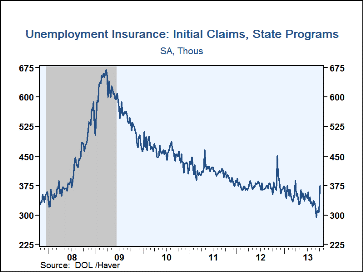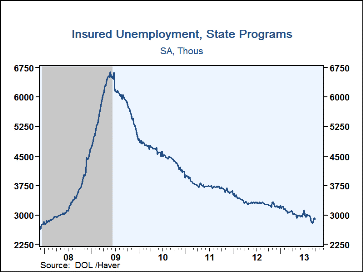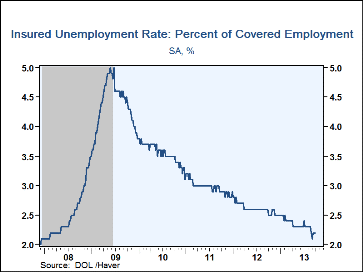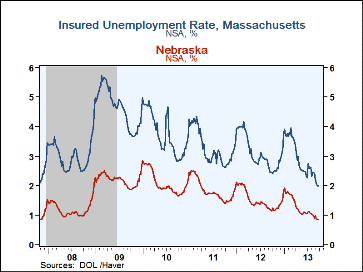 Global| Oct 10 2013
Global| Oct 10 2013U.S. Initial Claims for Jobless Insurance Jump with Shutdowns & Glitches
by:Tom Moeller
|in:Economy in Brief
Summary
The lines to file for unemployment insurance grew last week to their longest since January. Initial claims for jobless insurance jumped 66,000 to 374,000 (6.3% y/y) during the week ended October 5 from an unrevised 308,000 during the [...]
The lines to file for unemployment insurance grew last week to their longest since January. Initial claims for jobless insurance jumped 66,000 to 374,000 (6.3% y/y) during the week ended October 5 from an unrevised 308,000 during the prior week. The Department of Labor indicated that roughly 15,000 non-federal workers were affected by the government shutdown. Resolution of earlier computer issues in California accounted for the rest of the increase in claims. The Action Economics Forecast Survey expected 310,000 claims. The four-week moving average of initial claims increased to 325,000, its highest since late-August.
Continuing claims for unemployment insurance in the week ended September 28 slipped to 2.905 million (-11.2% y/y). The figure remained up from the early-September low of 2.788 million. The four-week moving average of continuing claims rose slightly to 2.859 million. The insured rate of unemployment held steady at 2.2%. This particular count covers only "regular" programs and does not include all extended benefit and other specialized jobless insurance programs. In the week of September 21, the latest figure available, the total of all benefit recipients ticked up to 4.028 million (-20.2% y/y). This broader measure is not seasonally adjusted. It compares to a cycle peak of 12.060 million in January 2010 and pre-recession figures that averaged 2.596 million for 2007. The number of individuals who were collecting emergency and extended payments in the week of September 21 slipped to 1.442 million (-31.5% y/y).
By state, the insured rate of unemployment continued to vary greatly with Nebraska (0.84%), Virginia (1.10%), Ohio (1.31%), Maine (1.41%), Indiana (1.44%), Texas (1.48%) and Florida (1.53%) at the low end of the range. At the high end were Wisconsin (1.96%), Massachusetts (1.98%), New York (2.30%), Illinois (2.44%), Pennsylvania (2.63%), California (3.00%) and New Jersey (3.12%).
Data on weekly unemployment insurance are contained in Haver's WEEKLY database and they are summarized monthly in USECON. Data for individual states are in REGIONW. The consensus estimates come from the Action Economics survey, carried in the AS1REPNA database.
The minutes to the latest FOMC meeting can be found here..
| Unemployment Insurance (000s) | 10/05/13 | 09/28/13 | 09/21/13 | Y/Y % | 2012 | 2011 | 2010 |
|---|---|---|---|---|---|---|---|
| Initial Claims | 374 | 308 | 307 | 6.3 | 375 | 409 | 459 |
| Continuing Claims | -- | 2,905 | 2,921 | -11.2 | 3,318 | 3,744 | 4,544 |
| Insured Unemployment Rate (%) | -- | 2.2 | 2.2 | 2.6 (9/12) |
2.6 | 3.0 | 3.6 |
| Total "All Programs" (NSA) | -- | -- | 4.028 mil. | -20.2 | 6.047 mil. | 7.750 mil. | 9.850 mil. |
Tom Moeller
AuthorMore in Author Profile »Prior to joining Haver Analytics in 2000, Mr. Moeller worked as the Economist at Chancellor Capital Management from 1985 to 1999. There, he developed comprehensive economic forecasts and interpreted economic data for equity and fixed income portfolio managers. Also at Chancellor, Mr. Moeller worked as an equity analyst and was responsible for researching and rating companies in the economically sensitive automobile and housing industries for investment in Chancellor’s equity portfolio. Prior to joining Chancellor, Mr. Moeller was an Economist at Citibank from 1979 to 1984. He also analyzed pricing behavior in the metals industry for the Council on Wage and Price Stability in Washington, D.C. In 1999, Mr. Moeller received the award for most accurate forecast from the Forecasters' Club of New York. From 1990 to 1992 he was President of the New York Association for Business Economists. Mr. Moeller earned an M.B.A. in Finance from Fordham University, where he graduated in 1987. He holds a Bachelor of Arts in Economics from George Washington University.










